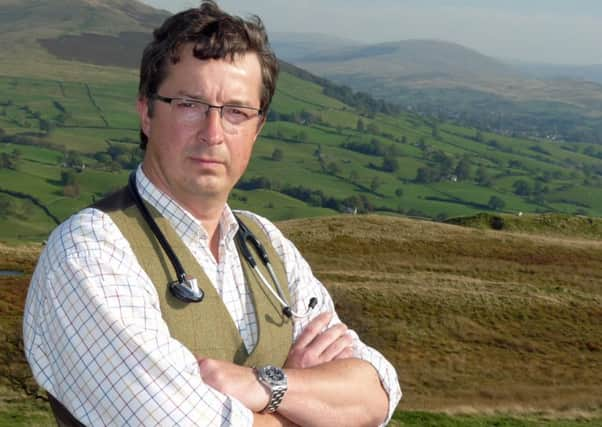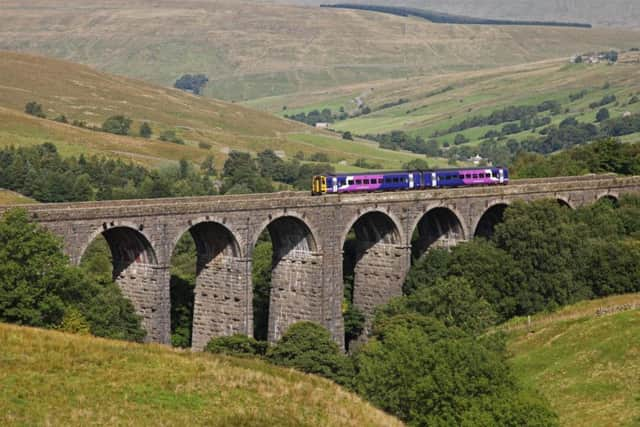Day in life of dales doctor


“I’m a sort of James Herriot for humans,” is how Sedbergh GP Dr William Lumb describes his work visiting patients who live within the 400 square miles of his Yorkshire Dales National Park practice.
“My definition of a rural practice is ‘one where there are more sheep than people’.”
Advertisement
Hide AdAdvertisement
Hide AdHe gestures at Dentdale’s breathtaking vale spread out below Fox’s Pulpit and removes the stethoscope I had asked him to wear around his collar for a snapshot. “This is very much the case here.”


He had invited me to accompany him while making his rounds and I’d put it to him that recent figures show many GP services are struggling for new recruits.
Some 280 practices in England have either closed or merged with each other in just 18 months, including 37 GP practices across Yorkshire. So is William one of a dying breed?
He suggests there are those still with a vocation for caring and healing who will always be drawn to such a hauntingly lonesome environment as a place of work. “But come along and see for yourself.”
Advertisement
Hide AdAdvertisement
Hide AdLonely farms dot the landscape, slate-grey or lime-washed white against the drab green of the moors as they perch isolated beneath limestone scars.


Tracks zig-zag their way up to them over narrow bridges and past waterfalls. The Settle-Carlisle Railway is often in view. So are farmers busy on quad bikes.
He is not always sure what to expect. Like the time he went to treat a man with breathing difficulties.
“I got a call to go to him,” he remembers. “Both doors of his home were locked.
Advertisement
Hide AdAdvertisement
Hide Ad“The lights were on. We knew he was in. The only way in was through the door.
“I borrowed a sledgehammer and put the door in. Then I dealt with him.
“It was actually serious. You needed to be in and tending to him. So waiting 20 minutes for the police to arrive wasn’t acceptable.”
Was he OK about the door? “Oh, yes, he’s forgiven me. I’m allowed to talk about it.”
Advertisement
Hide AdAdvertisement
Hide AdWilliam is West Riding born and bred. He was born in Doncaster and was brought up in Huddersfield.
He sees Sedbergh as being still in the same region as the old West Riding “which was a very large beast indeed”.
It was in 2004 that he arrived in Sedbergh, to be greeted by “God’s own country”.
“Basically,” he says, “our practice has a radius of 10 miles from Sedbergh, covers magnificent yet challenging upland countryside in every direction.
Advertisement
Hide AdAdvertisement
Hide Ad“Stretching? Very much so. The average GP in this part of the world will do a 12-hour day and work from 7am till 7pm or 8pm most days – like somewhere between a 55 and a 60-hour week is a standard working week for most rural GPs. Yes, taxing.”
Here he has two sides to his practice: on the one hand are the patients who live in the Dales; on the other, the ‘super’ surgery built on the lower slopes of Winder which overlooks the old market town celebrated for its public school and book festival.
William was the driving force behind Sedbergh’s walk-in Medical Centre, a comfortable, ultra-modern practice custom-built six years ago to replace the previous one, built in 1986 and which had rapidly became too small and outdated.
“It is very much an investment for the future. High quality preventive medicine is the aim. Community medicine is our focus.
Advertisement
Hide AdAdvertisement
Hide Ad“It is no less important than the blue-light stuff for emergency call-outs I do where sometimes speed is of the essence in getting from A to B,” he says.
“Here, health and social care teams have found that by identifying who’s most at risk, working more closely together to support those people at an earlier stage, and providing information to help people to take better care of themselves, they can start to address this issue head-on.
“They’ve found that this more streamlined, joined-up approach leads to providing services which people and their families and carers say are better for them.
“It can mean fewer people ending up in hospital or needing to move into residential care.
Advertisement
Hide AdAdvertisement
Hide Ad“Basically, the number of those with one or more long-term health conditions is increasing.
“We need to manage future demand – hence the park.
“We have a high home death rate in this part of the world.
“This is because we support people that have palliative care who want to die in their home.
“That doesn’t happen everywhere. People want to die in their own homes, but sometimes circumstances don’t just permit that to happen.
“So we work quite hard with our district nursing team and McMillan team to make sure people can die at home – if they want to.
Advertisement
Hide AdAdvertisement
Hide Ad“On one occasion,” he recalls, “an undertaker couldn’t reach the body of a patient who had died. It was a one-in-three gradient and there was a mile to go up a snow-drifted track.
“Thankfully I was able to walk up the icy track in my mountaineering boots, which I keep on board as I’m also a mountain rescue team member.
“Fortunately, farmhouses in the Dales are not the warmest places. There was no central heating. Stone floors added to the chill, and the window was open. This meant the family was not under too much pressure to shift the body immediately.”
He goes on: “Once a doctor has seen a body and agreed to issue a death certificate the body then legally becomes the property of the family. Only then can they at last organise for its collection by an undertaker.”
Advertisement
Hide AdAdvertisement
Hide AdAs I’m about to leave, he reminds me about the NHS buzzwords.
“Remember, Tony, ‘Integrated Care Community’. It’s such a key way of organising health and social care – a group of practices work together.
“Everything is tightly integrated. We’re quite advanced on it in this part of the world. How the population here in the western Dales benefit.
“Working with partners, patients and the public to support healthy living and self-care, we proactively manage the health and care needs of the most vulnerable people in our population. We help people to stay at home for longer.
“Basically, the patient always comes first.”
Advertisement
Hide AdAdvertisement
Hide AdI’d already seen this when I arrived two hours early due to a mix-up in my diary. “Sorry, you can’t sit in here,” William told me, referring to the spacious and comfortable waiting room for patients.
The incident amused waiting patients. “Evicted...” laughed a Dalesman wearing a boiler suit and wellies.
“Sorry, but a patient might need to sit there,” William explained as he ushered me to an available consulting room where I could spend the two hours, complete with wi-fi connection, settee and a coffee.
“Patients must come first...”